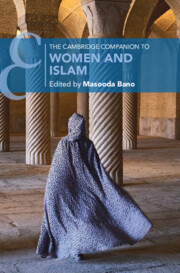Book contents
- The Cambridge Companion to Women and Islam
- Cambridge Companions to Religion
- The Cambridge Companion to Women and Islam
- Copyright page
- Contents
- Contributors
- Preface
- A Note on Foreign-Language Words
- Introduction
- Part I Logic of Classical Reasoning
- 1 Women in the Qur’an
- 2 Women’s Inheritance
- 3 Veiling and Restrictions on Sexual Liberty
- 4 Muhammad: The Ideal Man
- 5 Prophet’s Wives: “Mothers of the Believers”
- Part II Asserting Agency in Faith
- Part III Asserting Agency in Socio-Political Life
- Volume Bibliography
- Index
- Cambridge Companions To … (continued from page ii)
- References
3 - Veiling and Restrictions on Sexual Liberty
from Part I - Logic of Classical Reasoning
Published online by Cambridge University Press: 12 April 2025
- The Cambridge Companion to Women and Islam
- Cambridge Companions to Religion
- The Cambridge Companion to Women and Islam
- Copyright page
- Contents
- Contributors
- Preface
- A Note on Foreign-Language Words
- Introduction
- Part I Logic of Classical Reasoning
- 1 Women in the Qur’an
- 2 Women’s Inheritance
- 3 Veiling and Restrictions on Sexual Liberty
- 4 Muhammad: The Ideal Man
- 5 Prophet’s Wives: “Mothers of the Believers”
- Part II Asserting Agency in Faith
- Part III Asserting Agency in Socio-Political Life
- Volume Bibliography
- Index
- Cambridge Companions To … (continued from page ii)
- References
Summary
Katerina Nordin utilizes both specialized legal scholarship and vernacular Islamic literature to explore the nuanced debates surrounding veiling and restrictions on sexual freedom in Islam. The chapter discusses how many Muslim women adhere to these rulings by conscious choice, while also highlighting Islam’s encouragement of sexual pleasure for both genders within marriage and emphasizing that the extent of gender segregation remains negotiable.
- Type
- Chapter
- Information
- The Cambridge Companion to Women and Islam , pp. 85 - 105Publisher: Cambridge University PressPrint publication year: 2025

